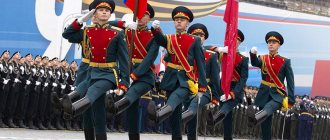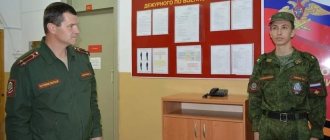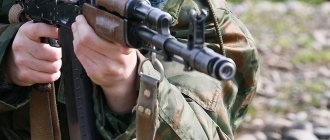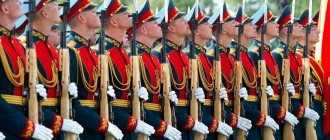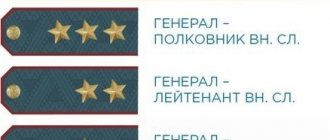Moscow. Kremlin. Honor guard at the eternal flame.
The honor guard company begins its historical development on November 29, 1956, when a separate company and honor guard orchestra were destined to move to a new subordination. The Moscow city military commandant’s office took the honor guard soldiers “under its wing”, and then placed them in the Aleshensky barracks. Major Slavin was appointed first to command that unit, and the leadership of the exemplary military orchestra of the guard of honor was entrusted to its first chief, Honored Artist of the RSFSR, Colonel Nikolaev.
Over almost half a century, the volume of tasks to be solved related to the provision of a wide variety of events has increased significantly. And these are not only garrison events, but also government and public events, so in the 90s it was decided to form a new expanded composition of the Guard of Honor.
The modern honor guard conducts meeting rituals, escorts heads of foreign delegations, and lays wreaths at the graves of soldiers who died in battles for the freedom and independence of our country. In addition, the Russian honor guard is engaged in the performance of rituals of military honors at the opening of new memorial complexes or during the burial of senior officials of the state, military-patriotic education of young people, as well as other socially significant events. Over the entire period of its known history, the honor guard has participated in more than 35 thousand special events in many Russian cities.
Performance by the military honor guard band at the military band festival
How the honor guard company lives and serves
The life of all military personnel is subject to a clear and strict routine, and each unit has its own. The same applies to the honor guard soldiers. The corresponding tables are placed at most stands near posts in the internal territory of the Arsenal. This is done so that it is always possible to verify the coincidence of the actual state of affairs with what is written in the graphs.
Like most military units, everyone gets up at 6:30. This is followed by a short exercise with a jog on the territory of the Kremlin, in all weather conditions. In order to successfully maintain the physical fitness of military personnel, a small sports town was built on the territory of the Tainitsky Garden, away from the gaze of tourists.
No more than an hour is allotted for making the beds, as well as for cleaning the interior and breakfast. Before lunch, four hours of training are required, as well as one hour to put the weapons of the honor guard personnel in order. Then another three-hour classes, “sampo”, and after dinner an evening walk and “lights out”. By and large, the daily routine of PKK military personnel is no different from most Russian military units.
Three times a week - on Thursday, Saturday and Sunday - visiting the club, and exclusively in dress uniform. The Kremlin is organized to watch Soviet and Russian films about the war, as well as to hold patriotic concerts and meetings with living veterans. The attitude towards bad habits is the same as everywhere else: smoking is not prohibited, but drinking alcoholic beverages is very strict.
Changing of the guard of honor
It is almost impossible to freely use mobile communications or the Internet in Arsenal buildings. With such a location it is not so easy. However, those who are required by duty have both computers and telephones in their offices. This is understandable, because on the territory of a regime military unit, regimental servicemen are allowed to use mobile phones, but without video and the Internet.
Conscripts will be able to take a walk on leave no earlier than after four months of service. The command is always worried about the personnel leaving for the city. And this is no coincidence, because many of the soldiers came from small towns, villages and hamlets, so it is possible that they could get lost behind the Kremlin walls.
Service prospects
The selection of candidates and service in the units of the 154th Separate Commandant Regiment is conventionally divided into several stages:
Selection of candidates
When selecting candidates, active work is organized with local authorities and organizations of military veterans. In some cases, complex competitions are held among young men.
Conscription service
The service period, like other units, is twelve calendar months. During this time, the soldier undergoes a young fighter course and masters one of the military specialties.
There are everyday restrictions. Thus, you can only use a mobile phone during certain hours. The phone itself should not have the Internet, video or audio recording capabilities. You can meet with friends and family in the visitors' room on the territory of the Kremlin building of the Spasskaya Tower (holidays and weekends are free from service).
Contract
The best soldiers, conscripts, are offered to continue serving on a contract basis. As a rule, this offer may come after six months of service. If a position requires the rank of “warrant officer,” it is assigned immediately. The contract is signed for five calendar years. At least 35.0% of contract soldiers serve in the PKK today.
PKK officer
During contract service, military personnel have the opportunity to undergo training and acquire higher military education. Having received the shoulder straps of a lieutenant, build a further career in any of the military units of our country.
Honor Guard Soldiers' Boots
One of the most important duties of the soldiers of the President's Regiment is maintaining an ideal appearance. The guard of honor is considered the calling card of not only the Kremlin, but also the capital, as well as the entire country. And therefore, issues related to appearance come first.
For example, the honor guard pays the greatest attention to the preparation of shoes. Moreover, it takes place taking into account internal rules, takes seven steps, which can last almost around the clock. Those Kremlinites who are supposed to do this spend hours polishing their boots.
RPK Boots
Gray-haired front-line soldiers
There are not only scattered visitors here, but also organized groups, newlyweds who, according to tradition, on the family’s birthday express gratitude to those who fought for the peaceful sky above their heads. On the morning of May 9 (Victory Day), front-line veterans come. Every year there are fewer and fewer of them, as time is inexorable.
View gallery
With Post No. 1, they are, one might say, the same age. When, back in the twenty-fourth year of the 20th century, the architect Alexei Viktorovich Shchusev was given the important task of building a crypt (Mausoleum) for the deceased father of the Country of Soviets, V.I. Lenin, some were just born, others were very small. They arrived here as young, blooming boys, men in the prime of their lives.
Initially, the Mausoleum was built of wood. A small cube of dark gray color, and above it a pyramid of three steps (the total height of the tombstone was 3 meters). The first guard was posted on the twenty-sixth of January 1924 at 16:00. The honor was given to the cadets, the sons of farm laborers Grigory Koblov and Arseny Kashkin (the breeder was the son of a railway worker, Janos Meyszaros, a Hungarian by nationality). In the USSR, equality, brotherhood, and belonging to the simple working class were welcomed.
"Honor Guard" Uniform
And in the daily life of the Kremlin residents, like all military personnel, everything is elementary. The same summer camouflage set with high laced boots in the summer. In winter - a jacket with a hat with earflaps made of natural sheepskin.
Different units wear different dress uniforms. They are provided with uniforms of dark blue or dark green colors, caps, and in winter - overcoats. It should be especially noted that all the fabrics from which military uniforms are made are used exclusively natural and from domestic manufacturers.
More expensive, at a price of 60-80 thousand rubles, is the purchase of ceremonial uniforms for the Special Guard Company - the so-called historical costumes. They were purposefully developed taking into account the previous ceremonial military uniforms, in which the Life Guards units of the 1907-1913 models were dressed. They were created, guided by the direct instructions of Nicholas II, in order to celebrate the anniversary of the victory in the Patriotic War of 1812. A dress uniform similar in cut was made for participants in the 1945 Victory Parade.
Changing of the Guard Schedule 2022 at Buckingham Palace
From January 2022, a new Changing of the Guard ceremony schedule has been introduced, allowing tourists to plan their tour times and allowing motorists to know specific days and times of road closures near Buckingham Palace.
The ceremonial changing of the guard at Buckingham Palace will be held on the following days:
- From August to March: Monday, Wednesday, Friday, Sunday from 11:00 to 11:45.
- From April to July: every day from 11:00 to 11:45.
The changing of the guard schedule may change due to other holidays, events or bad weather. The exact schedule can always be found on the official website.
Buy a ticket to the best places to watch the changing of the guard and visit the palace with an audio guide.
Ticket to Changing of the Guard at Buckingham Palace with guide Buy at
Buy a ticket for the Changing of the Guard at Buckingham Palace Buy at
To view the Changing of the Guard from the best angles, take high-quality photographs, and also visit other interesting places at Buckingham Palace, use the form below.
Tickets and guided tours to Buckingham Palace. Buy at
How do the Kremlin people eat?
Kremlin residents, like all conscripts, are provided with three meals a day. However, doctors and nutritionists have developed a balanced diet specifically for this unit. For many years, food products have been purchased exclusively from domestic producers.
Additional food is provided when tactical exercises or sports competitions are held. Recently, the command of the Presidential Regiment began to pay more attention to special table settings. All military personnel are now served individually portioned meals using porcelain dishes.
How to join the honor guard
They call for young recruits from all 48 Russian regions. Today, young people from most of the regions of our state are serving in the regiment. Even before the start of the spring and autumn conscription campaign, regimental officers go on business trips. And already there, on the spot, they are engaged in the preliminary selection of candidates for conscription in order to have lists of selected young people at the beginning of the official conscription.
The harsh everyday life of the honor guard
The requirements for future Kremlin members are numerous. Basically, they were prescribed in a government decree of 1999, together with the rest of the provisions. Among them:
- Height 175-190 cm;
- Weight is the normal ratio of height to body weight;
- Visual acuity without correction is 0.7 for both eyes and with normal color perception;
- Hearing is the perception of speech in a whisper from a distance of at least 6 meters for both ears.
Among the many Kremlin traditions, the meeting of “graduates” is quite popular. At such events, “graduates” exchange experiences with modern soldiers. It should be noted that at the end of their service, former Kremlin members who know firsthand what an honor guard is, have no problems with either education or getting a job. This military elite is literally being snapped up.
Greatness of Memory
On the anniversary of Lenin’s death, along with the “Kremlins,” representatives of other military schools and regiments, as well as workers and peasants who deserved such an honor, served. Eyewitnesses of past events sometimes cry from overwhelming feelings when the changing of the guard occurs. On Red Square, the process once looked simple and severe. But also majestic.
By 1929, the idea had matured to build a stone Mausoleum that would retain its familiar outlines. The construction commission was headed by K. E. Voroshilov. The author of the project was the irreplaceable Shchusev. He did not copy the wooden structure, but implemented new forms.
View gallery
During the finishing work, the structure was clad in granite and marble. Since 1935, guard duty has been carried out by soldiers of the Kremlin garrison. When the enemy approached Moscow, the leader’s body was evacuated to Tyumen. The sentries changed to the sound of wheels (simultaneously in Moscow at the Mausoleum throughout the war). In the 1950s, after the death of the leader of the Soviet state I.V. Stalin, the inscription “Lenin-Stalin” was visible above the entrance for some time. There were many more events. The traditions of changing the guards of honor have changed. As mentioned above, in 1966, the Tomb of the Unknown Soldier appeared near the Kremlin. For some time there was no permanent post near her. Now it works. The memory of the people's feat is alive and protected.
